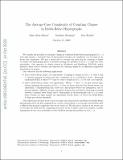| dc.contributor.author | Boix-Adsera, Enric | |
| dc.contributor.author | Brennan, Matthew | |
| dc.contributor.author | Bresler, Guy | |
| dc.date.accessioned | 2021-02-19T21:51:27Z | |
| dc.date.available | 2021-02-19T21:51:27Z | |
| dc.date.issued | 2020-01 | |
| dc.date.submitted | 2019-11 | |
| dc.identifier.isbn | 9781728149523 | |
| dc.identifier.issn | 2575-8454 | |
| dc.identifier.uri | https://hdl.handle.net/1721.1/129934 | |
| dc.description.abstract | The complexity of clique problems on Erds-Rényi random graphs has become a central topic in average-case complexity. Algorithmic phase transitions in these problems have been shown to have broad connections ranging from mixing of Markov chains and statistical physics to information-computation gaps in high-dimensional statistics. We consider the problem of counting k-cliques in s-uniform Erds-Rényi hypergraphs G(n, c, s) with edge density c and show that its fine-grained average-case complexity can be based on its worst-case complexity. We prove the following: •Dense Erds-Rényi hypergraphs: Counting k-cliques on G(n, c, s) with k and c constant matches its worst-case complexity up to a polylog(n) factor. Assuming ETH, it takes nΩ(k) time to count k-cliques in G(n, c, s) if k and c are constant. • Sparse Erds-Rényi hypergraphs: When c = Θ(n-α), for each fixed α our reduction yields different average-case phase diagrams depicting a tradeoff between runtime and k. Assuming the best known worst-case algorithms are optimal, in the graph case of s = 2, we establish that the exponent in n of the optimal running time for k-clique counting in G(n, c, s) is ωk/3-C α (k/2) + O-k, α (1), where ω/9 ≤ C ≤ 1 and ω is the matrix multiplication constant. In the hypergraph case of s ≥ 3, we show a lower bound at the exponent of k-α (k/s) + O-k, α (1) which surprisingly is tight against algorithmic achievability exactly for the set of c above the Erds-Rényi k-clique percolation threshold. Our reduction yields the first known average-case hardness result on Erdos-Renyi hypergraphs based on a worst-case hardness assumption. We also analyze several natural algorithms for counting k-cliques in G(n, c, s) that establish our upper bounds in the sparse case c = Θ(n-α). | en_US |
| dc.language.iso | en | |
| dc.publisher | Institute of Electrical and Electronics Engineers (IEEE) | en_US |
| dc.relation.isversionof | http://dx.doi.org/10.1109/focs.2019.00078 | en_US |
| dc.rights | Creative Commons Attribution-Noncommercial-Share Alike | en_US |
| dc.rights.uri | http://creativecommons.org/licenses/by-nc-sa/4.0/ | en_US |
| dc.source | arXiv | en_US |
| dc.title | The Average-Case Complexity of Counting Cliques in Erdős-Rényi Hypergraphs | en_US |
| dc.type | Article | en_US |
| dc.identifier.citation | Boix-Adsera, Enric et al. "The Average-Case Complexity of Counting Cliques in Erdős-Rényi Hypergraphs." IEEE 60th Annual Symposium on Foundations of Computer Science, November 2019, Institute of Electrical and Electronics Engineers, January 2020. © 2019 IEEE | en_US |
| dc.contributor.department | Massachusetts Institute of Technology. Department of Electrical Engineering and Computer Science | en_US |
| dc.relation.journal | IEEE 60th Annual Symposium on Foundations of Computer Science | en_US |
| dc.eprint.version | Author's final manuscript | en_US |
| dc.type.uri | http://purl.org/eprint/type/ConferencePaper | en_US |
| eprint.status | http://purl.org/eprint/status/NonPeerReviewed | en_US |
| dc.date.updated | 2020-12-03T17:29:56Z | |
| dspace.orderedauthors | Boix-Adsera, E; Brennan, M; Bresler, G | en_US |
| dspace.date.submission | 2020-12-03T17:30:03Z | |
| mit.license | OPEN_ACCESS_POLICY | |
| mit.metadata.status | Complete | |
